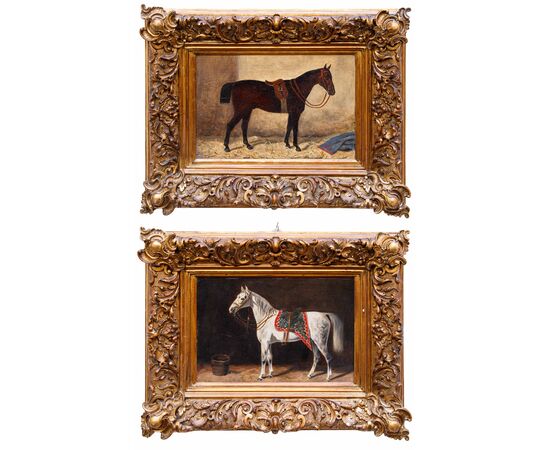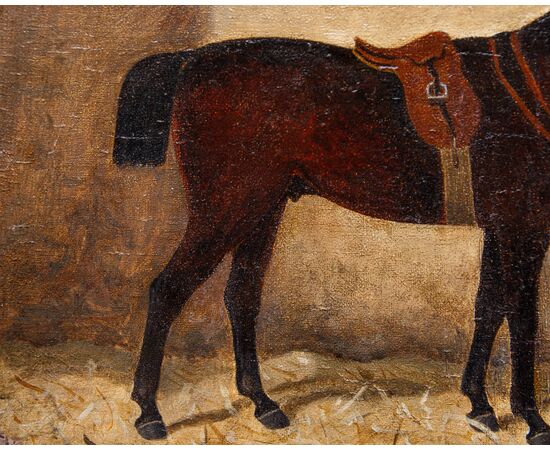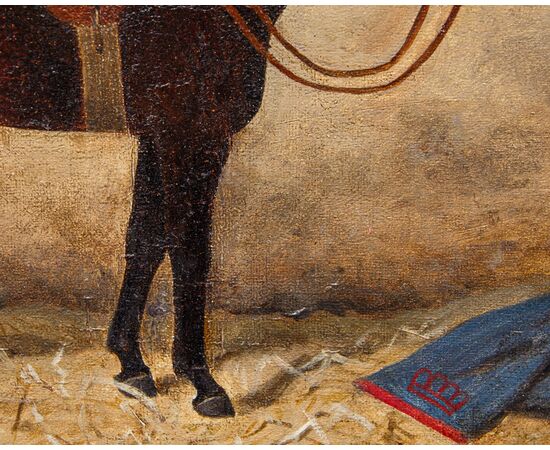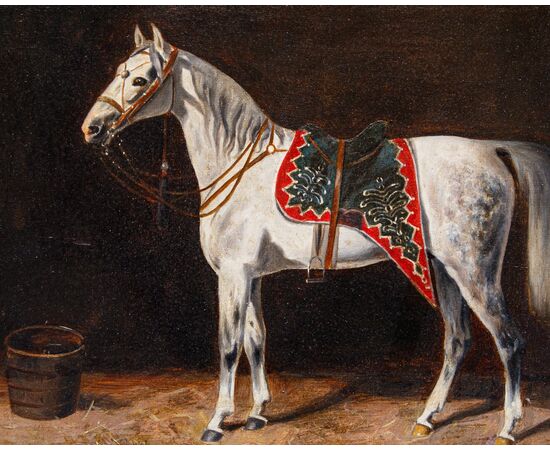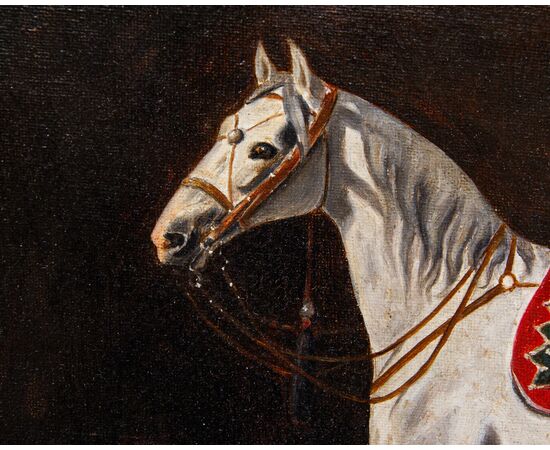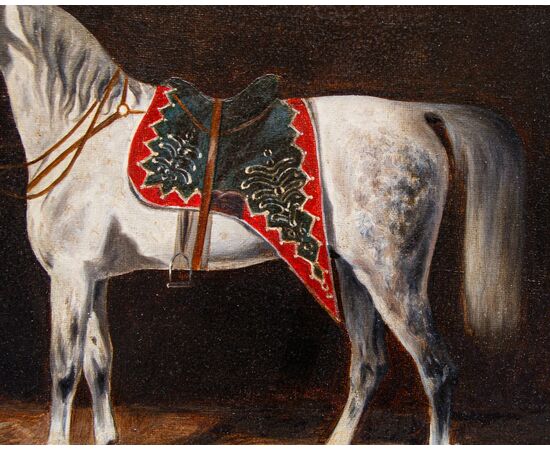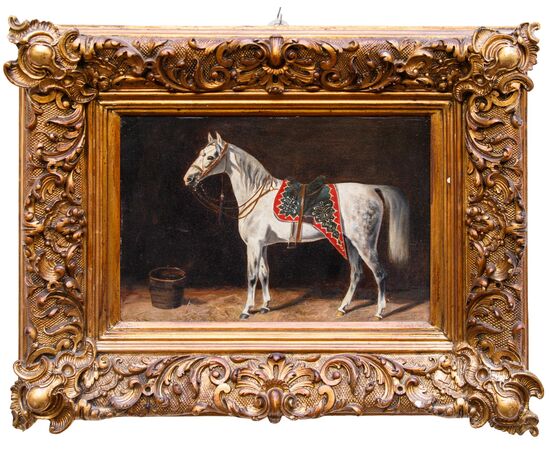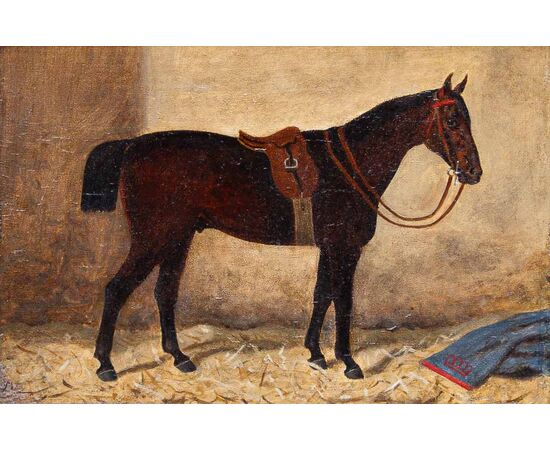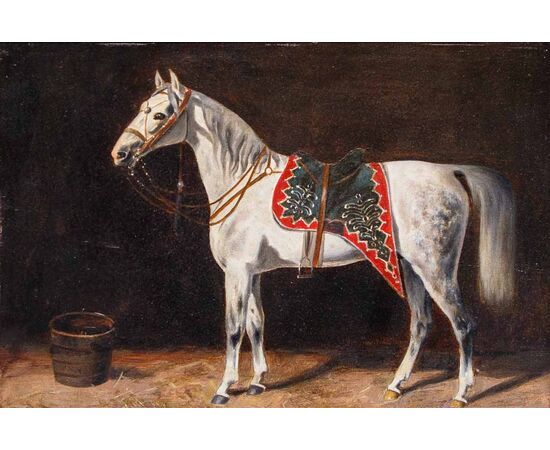Emil Volkers (Birkenfeld, 1831 - Dusseldorf, 1905), attributed to, Pair of horses
Emil Volkers (Birkenfeld, 1831 - Dusseldorf, 1905), attributed to.
Pair of horses
(2) Oil on canvas, 25x36 cm
With frame, 42x50 cm
In the vast panorama of 19th-century German art, where attention was divided between romantic landscapes, bourgeois portraits, and historical scenes, the figure of Emil Volkers (1831-1905) emerges. Volkers carved out a distinctive and highly appreciated niche, becoming the quintessential painter of the horse and, by extension, of Prussian military life of his time. His works are not only testimonies of exceptional technical skill, but also valuable visual documents of an era and a culture in which the horse still played a central role, both in agriculture and, above all, in the military sphere. Born on February 16, 1831, in Birkenfeld, near Bremen, Emil Volkers showed a marked inclination for art from a young age. His artistic training began with preliminary studies in his hometown, and then continued, as was customary for many young German talents of the time, at the Art Academy of Düsseldorf. Here, under the guidance of esteemed masters, he refined his skills in drawing and painting, but it was his innate passion for animals, especially horses, that directed him towards the specialization that would make him famous. What distinguishes Volkers is his deep understanding of equine anatomy and his ability to capture the energy, grace, and power of these magnificent animals. His horses are not mere details in a scene; they are the true protagonists, portrayed with a vividness and realism that reveal hours of careful observation and meticulous study. Whether they are racehorses at full speed, sturdy workhorses, or elegant parade steeds, Volkers managed to render every muscle, every tension, every expression with almost scientific precision, yet imbued with life. This specialization naturally led him to paint a large number of military scenes, particularly those related to the Prussian army. The era in which Volkers lived was a period of great changes and conflicts for Germany, culminating in unification under Prussian leadership. The army was a fundamental component of society and politics, and horses were indispensable for cavalry, artillery, and transport. Volkers became the visual chronicler of this reality. His canvases often depict military maneuvers, cavalry charges, field scenes, parades, and equestrian portraits of officers. He did not limit himself to rendering the mere action; his works are rich in details that tell the life of the soldier on horseback, the equipment, the uniforms, and the surrounding environment. His ability to set the scenes in realistic landscapes, often with dramatic skies or particular lighting effects, added depth and atmosphere to his compositions. In addition to military scenes, Volkers also painted numerous portraits of specific horses, often commissioned by stable owners, breeders, or aristocrats who wished to immortalize their precious animals. These works are a tribute to the beauty and majesty of the horse, and show his mastery in rendering the different breeds and individual equine personalities. Volkers' fame spread rapidly, and his works were in high demand both by private collectors and by military institutions. His style was characterized by a precise but vibrant brushstroke, a rich palette, and great attention to light and shadow, which gave his canvases an impression of three-dimensionality and dynamism. Emil Volkers died on April 29, 1905, in Düsseldorf, leaving behind a significant artistic legacy. His works are not only a pleasure for horse and painting lovers, but also valuable historical sources for anyone who wants to understand military culture and daily life in 19th-century Germany. Through his canvases, Volkers not only celebrated the power and beauty of the horse, but elevated its figure to a symbol of an entire era, making it a true protagonist of history and art.
In this pair of paintings, the absolute technical skill of the German painter is fully evident, which, throughout his production, shows references to his academic training. What emerges is the absolute importance given to the figure of the horse, which, from a simple animal, is transformed into an absolute symbol of an era.

